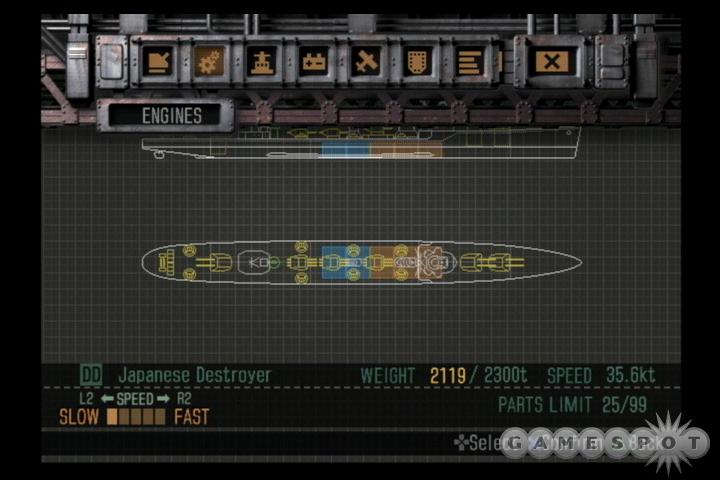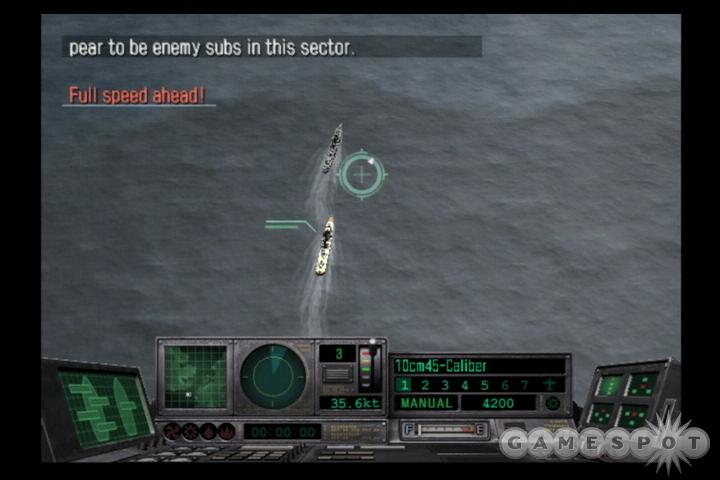Never let it be said that Koei is completely stuck in ancient China. Sometimes the company ventures out onto the alternate-reality high seas, too. That's what happened last summer with Naval Ops: Warship Gunner, a hybrid action and strategy game that put you in the role of a World War II fleet commander pulled through a space-time rift into a strange new world. Now Koei has followed up Warship Gunner with a new sequel, Naval Ops: Commander, which maintains the basic game structure of its predecessor while changing and refining some of the mechanical elements. It's a pretty dry game that's a little too light on the action for people who don't like an equal dose of slowly paced strategy, but if you're as much into customizing your own ship as you are blowing other ships to pieces, Naval Ops: Commander might be for you.

Unlike last time, the new Naval Ops doesn't even try to establish a realistic link to Earth--which isn't to say that interdimensional portals are very realistic to begin with. Anyway, this time you're embroiled in a completely fictional conflict between two nations, Virshia and Navishia. Virshia begins a policy of aggressive expansion using technologically advanced warships, and after Navishia's mission command center is destroyed, that country's freely operating battleships will have to band together to combat the Virshian threat. The game is pretty thin on story--this basic setup is all the impetus provided to get you out on the water and shooting things. You'll get brief voice-overs between missions to let you know what's going on in the war, but that's about it.
There are two distinct modes of play in Naval Ops: Commander. During the actual missions, it's an action game, with battles between warships, carriers, airplanes, and the like being fought from an overhead perspective in real time. The action mode has seen some conspicuous changes from the first Naval Ops. You have a fairly large degree of control over the camera now, so you can move it all around the map and zoom in and out on the action. A target lock-on feature will lock your crosshairs on a nearby enemy if desired, or you can aim manually, if that's your thing. The naval combat is really quite straightforward--you throttle your ship up and down, steer left and right, and shoot at things. There are some pretty diverse mission objectives available--sometimes you'll be tasked with sinking a particular group of nasty ships, while other times you'll have to disable radar installations or trash a runway to stop the enemy from launching its planes. Secondary objectives will pop up during the stages, and these give you a greater chance for glory before you move on to the next mission.
Aside from the control and camera changes, the biggest addition to the action portion of Naval Ops is the new escort system. You can now have up to three escort ships traveling with you at all times, and you can define their behavior in a number of ways. There are four basic formations that provide varying degrees of offensive and defensive strength, and these formations actually do seem to make a difference during gameplay. You can also go into solo mode and have your escorts sit tight and guard an area. Generally, the escort ships are a nice addition to the gameplay and work pretty well, although occasionally they'll get themselves killed or get stuck on a landmass at the wrong time.
Between the missions, Naval Ops: Commander is a strategy game and shipbuilding simulation. You'll receive funding based on your performance in the missions, and you can put this money toward an almost absurd number of upgrades and customizations for your fleet. There are several ways to build a better warship. You can invest money in R&D for weapons, engines, armor plating, and more--this investment will yield the invention of better items that you can then buy and equip your existing ship with. You'll start out with conventional weapons, like massive deck guns and torpedoes, although later in the game you can even access some outlandish stuff like lasers. You can also save up a ton of money and just buy a prebuilt stock ship to replace the one you have, if you're feeling lazy, but the truly hardcore shipbuilder will want to design and construct a ship from the ground up that meets his or her specifications. The game does in fact let you do this, all the way down to where you want to place the engines or weapons in your design. There's a crazy amount of depth to the strategy mode, but only the most devoted and patient players will really ever tap it. If you're looking for less talking and more shooting, you'll probably just find this part boring.

Since Commander is a straightforward action game on one end and a stodgy simulation on the other, it's not surprising that its visual presentation isn't very interesting. The graphics in the action stages are more functional than they are attractive--they feature small ship and airplane models, basic terrain, and a flat water effect that get the job done but don't really impress. At least the frame rate is smooth throughout, though. The sound effects in the game are done well enough, with decent gunfire and explosions and so on. Alas, the voice acting is truly grating, which wouldn't be so bad if you heard it only between missions. However, you'll get vocal announcements during missions too, when you change formations and that sort of thing. Naval Ops' music is fairly rousing, in a campy sort of way, but it's not particularly memorable.
Naval Ops: Commander is a no-frills action and strategy game that's pretty much tailor-made for a specific audience of patient gamers. You'll find hours upon hours of depth in the strategy mode, and committed players will be able to design and tweak better warships to create the ultimate fighting vessel. With more than 80 missions available, the action component is lengthy too, if not particularly complex or flashy. If you like some strategic meat with your shooting, Commander is worth a look. Those hoping for a more quickly paced affair, however, would be better served elsewhere.